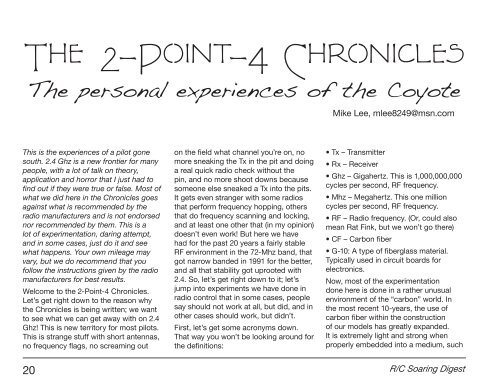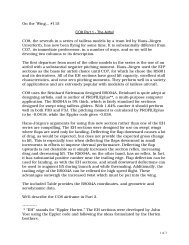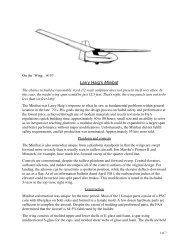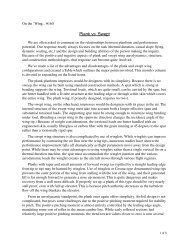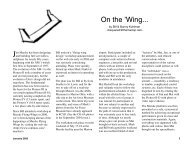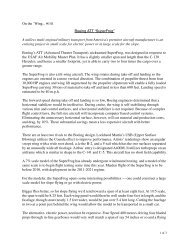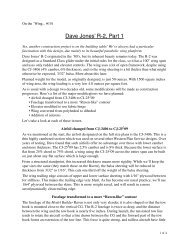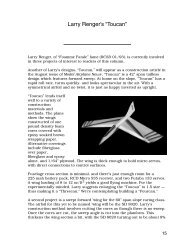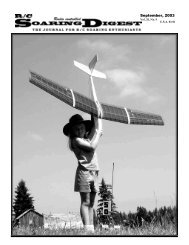Mar - Rcsoaring.com
Mar - Rcsoaring.com
Mar - Rcsoaring.com
Create successful ePaper yourself
Turn your PDF publications into a flip-book with our unique Google optimized e-Paper software.
The 2-Point-4 Chronicles<br />
The personal experiences of the Coyote<br />
Mike Lee, mlee8249@msn.<strong>com</strong><br />
This is the experiences of a pilot gone<br />
south. 2.4 Ghz is a new frontier for many<br />
people, with a lot of talk on theory,<br />
application and horror that I just had to<br />
find out if they were true or false. Most of<br />
what we did here in the Chronicles goes<br />
against what is re<strong>com</strong>mended by the<br />
radio manufacturers and is not endorsed<br />
nor re<strong>com</strong>mended by them. This is a<br />
lot of experimentation, daring attempt,<br />
and in some cases, just do it and see<br />
what happens. Your own mileage may<br />
vary, but we do re<strong>com</strong>mend that you<br />
follow the instructions given by the radio<br />
manufacturers for best results.<br />
Wel<strong>com</strong>e to the 2-Point-4 Chronicles.<br />
Let’s get right down to the reason why<br />
the Chronicles is being written; we want<br />
to see what we can get away with on 2.4<br />
Ghz! This is new territory for most pilots.<br />
This is strange stuff with short antennas,<br />
no frequency flags, no screaming out<br />
on the field what channel you’re on, no<br />
more sneaking the Tx in the pit and doing<br />
a real quick radio check without the<br />
pin, and no more shoot downs because<br />
someone else sneaked a Tx into the pits.<br />
It gets even stranger with some radios<br />
that perform frequency hopping, others<br />
that do frequency scanning and locking,<br />
and at least one other that (in my opinion)<br />
doesn’t even work! But here we have<br />
had for the past 20 years a fairly stable<br />
RF environment in the 72-Mhz band, that<br />
got narrow banded in 1991 for the better,<br />
and all that stability got uprooted with<br />
2.4. So, let’s get right down to it; let’s<br />
jump into experiments we have done in<br />
radio control that in some cases, people<br />
say should not work at all, but did, and in<br />
other cases should work, but didn’t.<br />
First, let’s get some acronyms down.<br />
That way you won’t be looking around for<br />
the definitions:<br />
• Tx – Transmitter<br />
• Rx – Receiver<br />
• Ghz – Gigahertz. This is 1,000,000,000<br />
cycles per second, RF frequency.<br />
• Mhz – Megahertz. This one million<br />
cycles per second, RF frequency.<br />
• RF – Radio frequency. (Or, could also<br />
mean Rat Fink, but we won’t go there)<br />
• CF – Carbon fiber<br />
• G-10: A type of fiberglass material.<br />
Typically used in circuit boards for<br />
electronics.<br />
Now, most of the experimentation<br />
done here is done in a rather unusual<br />
environment of the “carbon” world. In<br />
the most recent 10-years, the use of<br />
carbon fiber within the construction<br />
of our models has greatly expanded.<br />
It is extremely light and strong when<br />
properly embedded into a medium, such<br />
20 R/C Soaring Digest


